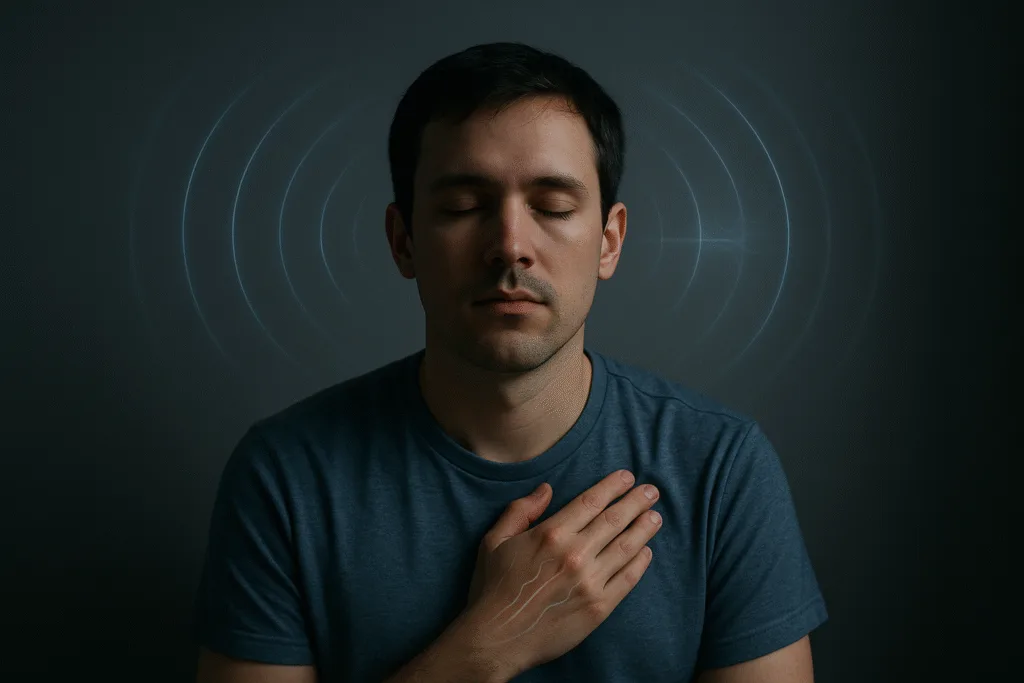The dark hearing boost test reveals what happens when your brain shifts priority from sight to sound. Humans are visual creatures — up to 70% of the brain’s sensory processing is dedicated to vision. But when light drops, your brain performs an ancient survival maneuver: it enhances hearing to compensate for the loss of visual information.
This adaptation is fast, subtle and incredibly effective. Even mild darkness can make your hearing feel sharper, deeper or more directional. This test allows you to observe that switch happening in real time.
O experimento abaixo mostra exatamente como isso ocorre.
Step 1 — Enter a Room With Very Low Light
You don’t need complete darkness — just enough dimness to limit visual details.
Shadows become softer.
Edges fade.
Depth perception reduces.
This is the ideal environment to trigger the dark hearing boost test.
Step 2 — Sit Still and Let Your Eyes Relax
As you sit quietly, your visual system begins to “step back.”
It stops processing unnecessary details and reduces its internal noise.
This shift frees resources for your auditory system.
Within seconds, your brain starts enhancing sound perception.
Step 3 — Close Your Eyes for Five Seconds
With vision removed completely, your brain increases sensitivity in the auditory cortex.
You may notice:
- distant sounds becoming clearer
- subtle noises appearing
- a “wider” sense of hearing
- sharper direction awareness
This is the beginning of the hearing boost.
Step 4 — Focus on the Farthest Sound in the Room
Procure o som mais distante.
It might be:
- a fan
- traffic through a window
- distant voices
- humming electronics
Your brain expands its listening field because it is no longer competing with visual input.
This is one of the clearest moments of the dark hearing boost test.

Step 5 — Slowly Open Your Eyes Without Moving Your Head
Open your eyes halfway.
Keep your head still.
Keep your ears active.
You may notice your hearing remains enhanced for a few seconds before slowly recalibrating. This moment shows how the brain gradually restores visual priority.
Step 6 — Turn Your Head Slightly Toward a Subtle Sound
Gire o rosto levemente.
As you turn, your ears capture:
- small changes in volume
- directional cues
- resonance differences
- room acoustics
In low light, your brain amplifies these cues to help build a mental map of the space.
This is a survival mechanism that helped early humans navigate darkness.
Step 7 — Close Your Eyes Again and Listen to Your Own Breathing
Amaçar sua própria respiração creates an internal reference point.
Your brain uses this as a baseline to evaluate external sounds.
This comparison increases auditory clarity.
You may feel:
- slow breaths sounding louder
- the chest resonance becoming clearer
- ambient noise separating from internal noise
The test makes hearing feel more layered.
Step 8 — Tap Your Finger Lightly on Your Leg
Just a soft tap.
The sound will feel sharper, more defined, more immediate.
In darkness, the brain enhances the contrast between self-generated sounds and environmental sounds, helping you orient yourself.
This is one of the simplest and clearest effects of the dark hearing boost test.
Step 9 — Listen for the Quietest Sound You Can Detect
Every room has extremely soft sounds:
- distant hums
- air movement
- fabric shifting
- your own heartbeat
- subtle vibrations
In low light, the brain magnifies these details.
This is the deepest stage of the hearing boost.
Many people report hearing things they didn’t know existed in their environment.
Step 10 — Reopen Your Eyes Fully and Notice the Sensory Shift
When you fully reopen your eyes, observe how:
- hearing softens slightly
- visual input regains dominance
- direction awareness recalibrates
- sounds become less prominent
Your brain transitions back to a vision-led mode.
The change is subtle, but clear.
The dark hearing boost test shows how quickly your senses rebalance depending on which ones you rely on most.
What This Experiment Shows About Your Body
The test reveals cinco verdades fundamentais:
1. Your brain redistributes sensory resources instantly
When vision drops, hearing takes priority.
2. Darkness increases auditory sensitivity
Sound becomes clearer, sharper and more dimensional.
3. You can “train” your hearing by limiting light
Reducing visual input boosts auditory accuracy.
4. Sound direction becomes easier to detect
Your brain enhances spatial processing when eyes cannot guide you.
5. This reflex is evolutionary
Early humans depended on hearing to navigate dark environments safely.
Você ainda carrega esse mecanismo hoje — o teste apenas o torna consciente.
Next Safe Extreme You Should Try
If the dark hearing boost test revealed how your ears take over in low light, the next experiment will explore how your skin reacts to tiny electrical sensations generated by friction.
Recommended next article:
“The Static Tingle Surface Test — Feel Electricity Build on Your Skin”
